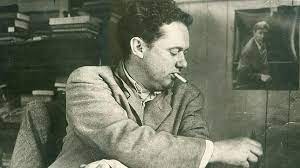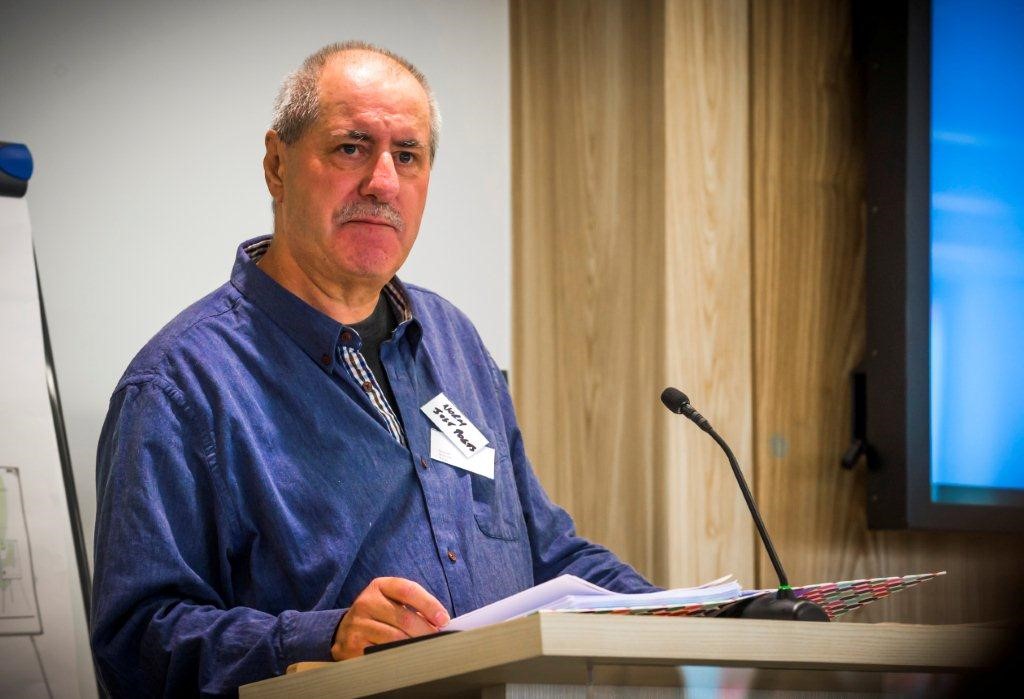UNDER MILK WOOD there are words beyond language
UNDER MILK WOOD there are words beyond language
says Norman Warwick
Several of the best moments of my life have been spent under milk wood. I was eleven, when I first heard the voice of Mr. Drury, in its honey-coated Hull tones, more akin to Phillip Larkin that Dylan Thomas (neither of who I had ever heard of at the time anyway, read out to us the prologue from Under Milk Wood,
To begin at the beginning:
It is Spring, moonless night in the small town, starless and bible-black, the cobblestreets silent and the hunched, courters’-and- rabbits’ wood limping invisible down to the sloeblack, slow, black, crowblack, fishingboat-bobbing sea. The houses are blind as moles (though moles see fine to-night in the snouting, velvet dingles) or blind as Captain Cat there in the muffled middle by the pump and the town clock, the shops in mourning, the Welfare Hall in widows’ weeds. And all the people of the lulled and dumbfound town are sleeping now.
And to bring us up to date, there is a wonderful exhibition running at a leading art gallery hosting a collection of work inspired by the famous Dylan Thomas words.

The gallery is in the heart of Mayfair, near Green Park Station in London. The company my dad worked for had a flat for the use of its directors and when I was first married my wife Dee and I would occasionally go down to London with my parents for the weekend, The first time we ever did so, Dee and I were strolling past the nearby Mayfair Theatre (left) where we saw a poster advertising the evening performance of a production of Under Milk Wood. By this time I was pretty familiar with the Richard Burton recordings and thought them so perfect that surely they could never be equalled
Nevertheless I couldn´t miss the opportunity to see the piece performed as a play. From the second the play began we were mesmerised. At seventy years old I look back and rue the feact that we couldn´t afford a programme that I might have saved to refresh my memory all these years later. I´m pretty sure the performance was by the Welsh National Opera Company (can that be right) but I have no idea of the any cast member´s names. I hate looking things up as it somehow seems disrespectful to those memories of the event I do still hild, but I guess I´ll have to try.
What I do remember, though, is how the gossipy voices of the village seemed to come from all points of a stage that was in blackness aprt from when a spotlight fell on the face of the speaker of the time. There was a definite Welshness to the language that I had heard from Burton, if not from Mr. Drury in my schooldays.

photo 2 Now, in 2022, Under Milk Wood is back in London in a different guise, in a defferent art form even. A trip to the Waddington Custot Galleries (right) between 11th June and 23rd July would prove very rewarding for lovers of Dylan Thomas the poet, Under Milk Wood the play, or Peter Blake the artist
Originally established on Cork Street in 1958 as Waddington Galleries, Waddington Custot was formed in 2010 with the partnership of long-time London art dealer Leslie Waddington, and French art dealer Stephane Custot. Since becoming sole owner in 2015, Custot has welcomed renowned artists with whom he has a close connection, including Fabienne Verdier, Zao Wou-Ki, Hans Hartung, Chu Teh-Chun, Pierre Soulages and Bernar Venet. The gallery has since cultivated a rich heritage and an international reputation for expertise in outstanding works by modern and contemporary masters, with a particular focus on monumental sculpture. In 2021, Custot was awarded the title of Officer of the French Order of Arts and Letters, awarded each year by the French Minister of Culture to significant figures in the arts and literature.
The gallery continues to build on its sterling renown and over 60 years of experience, leading with high quality and well-researched exhibitions featuring significant artists of the mid-twentieth century and beyond. Today, Waddington Custot represents foremost contemporary and modern artists and their estates including David Annesley, Peter Blake, Patrick Caulfield, Ian Davenport, Allan D’Arcangelo, Robert Indiana, Jedd Novatt, Pablo Reinoso, Bernar Venet and Fabienne Verdier. The inventory includes works by important modern European artists including Josef Albers, Jean Dubuffet, Hans Hartung, Fausto Melotti, Joan Miró, Pierre Soulages and Maria Helena Vieira da Silva. The gallery’s long-standing focus on heavyweight American artists continues through strong relationships with John Chamberlain, Peter Halley, Robert Rauschenberg, Frank Stella and John Wesley.

The Waddington Galleries was founded in 1958 by Victor Waddington, a venerable Dublin art dealer, with his son Leslie. The gallery opened in March of that year at 2 Cork Street, in the heart of London’s Mayfair, with an exhibition of late works by Jack B. Yeats, who Victor Waddington had represented in Ireland. Through the years, the gallery would become preeminent in Cork Street and the Waddington name (left) synonymous with it.
The new London gallery continued its tradition, exhibiting paintings and drawings by Yeats and smaller works from the School of Paris, including Henri Matisse and Pablo Picasso. It also introduced the work of British artists emerging from St Ives – Terry Frost, Patrick Heron and Roger Hilton – and painters and sculptors such as Ivon Hitchens, Elisabeth Frink and William Turnbull.
In February 1965, The Waddington Galleries opened a second gallery space at 25 Cork Street, opposite No. 2. The following year, Victor Waddington moved to this new address, setting up the Victor Waddington Gallery, while Leslie Waddington remained at 2 Cork Street and established his own, separate business, keeping the Waddington Galleries name.

Under Leslie Waddington (right) , Waddington Galleries increased its focus on contemporary British artists, in particular those featured in Bryan Robertson’s ‘New Generations’ exhibitions, held at the Whitechapel Gallery in the mid-1960s, such as David Annesley and Michael Bolus. In November 1968, Leslie opened the Leslie Waddington Gallery around the corner at 8 Vigo Street, specialising in prints. This gallery would become Waddington Graphics, moving to Clifford Street, at No. 16 and later in adjacent 31 Cork Street. Waddington Graphics closed in January 1995, becoming Alan Cristea Gallery under the ownership of the previous gallery director.
On 4 December 1969, Waddington Galleries announced the opening of two further galleries at 34 Cork Street, named Waddington Galleries II and III, with No. 2 being Waddington Galleries I. The gallery became instrumental in the promotion of post-war American art in Britain. From 1969 and throughout the 1970s, the gallery hosted exhibitions of work by American Color Field painters, including Morris Louis, Kenneth Noland and Jules Olitski. As a precursor, the influential work of master colourist, Milton Avery, had been first exhibited at the gallery in 1962.
As well as exhibiting recent work by international contemporary artists, there were numerous shows of European masters, such as Fernand Léger, Matisse and Picasso. British artists, Peter Blake and Patrick Caulfield, were given their first exhibitions at the gallery in 1971 and 1972 respectively, and Ben Nicholson in 1976. In the summer of 1972, the gallery collaborated with Jean Dubuffet for the first time with an ambitious exhibition displayed in all three Waddington Galleries’ spaces and at Victor Waddington.
For two years, Waddington joined forces with Arthur Tooth & Sons, a long-established London gallery on Bruton Street dating back to the mid-19th century. The inaugural exhibition of Waddington and Tooth Galleries opened on 30 November 1976. At the time, the merger created one of the largest modern art dealerships in Europe and the association lasted until the autumn of 1978.
The 1980s brought new artists to the gallery, including Michael Craig-Martin, Dan Flavin, Donald Judd, Mimmo Paladino and Julian Schnabel. Barry Flanagan, who had met Leslie Waddington in 1976, had his first show at Waddington Galleries in 1980. In 1982, Waddington Galleries – now under sole ownership by Leslie following the passing of his father – opened a fourth gallery at 4 Cork Street. This exhibition space was in use until the end of 1983, when the main gallery moved to 11 Cork Street, newly designed by British architect John Pawson. By the end of the 1980s, two additional Waddington galleries had been opened at 5 & 12 Cork Street.
A number of younger artists joined the gallery in the 1990s, including Ian Davenport, Michael Landy and Fiona Rae, all graduates of Goldsmiths College, London, who had been taught by Michael Craig-Martin. The group exhibition ‘From Here’, in 1995, celebrated this new generation of artists. Spanish artist, Antoni Tàpies, had his first show at the gallery in 1991 and his major exhibition, ‘A Summer’s Work’, in 1994, was the last at No. 5. The gallery took on representation of The Josef and Anni Albers Foundation in 1996. By the end of the decade, after the closure of No. 34 in 1998, Waddington Galleries was consolidated at 11 & 12 Cork Street, with the incorporation and re-design of the two galleries into one large exhibition space. Waddington Custot remains in that beautiful space to this day.
The gallery continued its pioneering work in the first decade of the 21st century, hosting the first London solo exhibition of Robert Indiana in over 10 years in 2004 as well as the first survey of John Wesley’s career in the United Kingdom in 2008. The estate of mid-century Italian modernist Fausto Melotti joined the gallery in 2006 with a first show focusing on sculpture and works on paper. Exhibitions at Waddington Galleries from 2000-2010 showcased a continued commitment to modern masters such as Albers and Avery while also celebrating new work from venerated artists Caulfield, Flanagan, Rauschenberg and Tàpies, and contemporary practitioners Craig-Martin, Axel Hütte, Lucas Samaras and Bridget Riley.

In 2010, Leslie Waddington entered into partnership with French art dealer Stephane Custot (left) to create Waddington Custot. Custot – becoming sole owner in 2015 after Waddington’s passing – would welcome artists to the gallery with whom he has a close connection, including Fabienne Verdier, Zao Wou-Ki, Hans Hartung, Chu Teh-Chun, Pierre Soulages and Bernar Venet. In 2016, the gallery exhibited ‘Vibration of Space’, creating an exciting dialogue between British painter Patrick Heron and non-figurative painters of post-war Paris: de Staël, Hartung and Soulages. Other ambitious group exhibitions include ‘Two Pataphysicians: Flanagan Miró’ (2014) and ‘Rodin, Brancusi, Moore: Through the Sculptor’s Lens’ (2015). In 2017, contemporary French painter Verdier joined the gallery and had her first solo exhibition in London, ‘Rhythms and Reflections’. Waddington Custot welcomed the estate of American artist Allan D’Arcangelo in 2018 and announced representation of conceptual artist and monumental sculptor Venet in 2020.

Now, there is an exhibition running through June and deep into July that houses a series of over 170 watercolours, collages and drawings by Sir Peter Blake to complement the landmark 1953 ‘play for voices’, Under Milk Wood, by Dylan Thomas (right) This can be viewed at Waddington Custot this summer, in a new, dedicated exhibition space opposite the main gallery at 22 Cork Street, London. The series has never before been shown outside of Wales, and this exhibition debuts a number of new works shown for the first time, as Blake has continued to work on the series. Under Milk Wood will open as Blake celebrates his 90th birthday.

Illustrating Under Milk Wood is a project that Blake (left) has been working on for over 40 years. The artist first heard the play as a student at the Royal College of Art, when it was broadcast on the radio in 1954, but his idea to create a series of illustrations based on the piece was conceived a quarter of a century later in 1979, when he was given a recording to listen to in the studio as he worked. Blake returned to, and abandoned, the project multiple times until the 1990s, before embarking on the series in earnest: “As soon as I decided to illustrate Under Milk Wood, I researched it, read it and listened to it again and again. I still play it a couple of times a week and read it once a month. I’ve always treated it as a separate piece of work. I work on Under Milk Wood at home in the evening. It’s almost like a ‘separate me’ doing it.”
Under Milk Wood tells the surreal story of the dreams and innermost thoughts of the inhabitants of a mythical Welsh seaside town called Llareggub. All is ‘strangely simple and simply strange’ as dawn breaks and we are first introduced to characters such as Captain Cat, Nogood Boyo and Polly Garter through their visceral dreams, before following them around their interwoven lives in Llareggub over the course of one day. Following the sequence of the play, Blake divides his work into three distinct sections: brightly-coloured watercolours of the characters’ dreams, collages which capture scenes and snippets of text from the play and portraits of each character rendered in hard pencil. Later watercolours, added to the series after Blake imposed his ‘artificial deadline’ on the project in 2013, captures new scenes and moments from the play.
Blake began the project by first working on capturing the dreams that open the play, which are variably surreal, lusty, meandering and absurd, deeply rich in their imagery and transportative to the innermost thoughts of the characters: Captain Cat is visited by five drowned men who imagine life on land and the people they have left behind in Llareggub; Mr Utah Watkins imagines a sheep with the head of his wife, ‘smiling and knitting and bleating’ as they leap the fences on the hill; Mrs Willy Nilly dreams she is being spanked by her teacher for being late to school. The surrealism of the language encouraged Blake to depict the passages as literally as possible in these 26 works. Where Thomas writes ‘Mrs Rose Cottage’s eldest, Mae, peels off her pink and white skin, in a furnace, in a cave, in a waterfall in a wood and waits there’, Blake paints exactly that, carefully layering the imagery. Blake says, of Thomas: “When he wrote those sequences, I don’t imagine he ever thought of it visually, he would have thought of it as words. So I really enjoyed making something that was never intended to be visual, visual.”
The second section of the exhibition illustrates specific passages of the text through a variety of media including collage and photographs. Some passages, such as a long list of items that wash up onto a beach, took Blake years to depict as he painstakingly sourced the images that make up the collage. Much of the photography was taken by Blake himself in 1986 on a visit to Laugharne in Carmarthenshire, Wales, the town where Thomas lived during his final four years and which is generally regarded as the inspiration for Under Milk Wood. It was on this visit that Blake coincidentally met Dylan Thomas’s widow, on her first trip back to the town since the author’s death.
The third section of the exhibition displays 60 pencil-drawn portraits of each character mentioned in the text. Each portrait is a ‘drawn collage’ based on a real person, or people; Blake believes that a face cannot be invented. For example, Elizabeth Taylor appears as Rosie Probert, as she does in the 1972 BBC film adaptation of the text. Waldo’s wife uncannily resembles Terry Wogan with long hair, and Mrs Willy Nilly has a similarity to the author Margaret Atwood; others are composites of different features: Blake has given Captain Cat his own beard.
Under Milk Wood was first shown in 2013 at the National Museum of Wales in Cardiff, to celebrate the centenary of Dylan Thomas’ birth, and subsequently at the Glynn Vivian Art Gallery in Swansea. This will be the first time the series has been shown in almost a decade and the first time it comes to London.
Under Milk Wood is presented in a dedicated temporary exhibition space at 22 Cork Street, across the street from the main gallery and is the third address on the street occupied by Waddington Custot. The gallery has a long history on the street, opening its first space at 2 Cork Street in 1958 and having as many as five different galleries on the street by the end of the nineteen eighties.

Yesterday, on Sunday 12th June, one of our favourite players Sheku Kannaeh-Mason, of Briatin´s best-loved musical families performed with Sir Simon Rattle and the London Symphony Orchestra in a free concert in Trafalgar Square! This was the first time they had performed live together since werecording Sheku´s album ‘Elgar’ back in 2019.

It has been a little while since we have heard from Sheku (right), but over the weekend he has given Sidetracks And Detours some new we know will excite you as it excites us.
There will a a new album this September called Song!
The first single from the album is a traditional Welsh song called Myfanwy. It is one of Sheku´s absolute favourite melodies and one he has known for as long as he can remember. He spent a lot of his childhood in Wales with his family and particularly my Welsh Grandma and, as he says of the album, ´this is for her´.
This album includes more of Sheku´s favourite music across different genres which he has arranged for the cello. he tells us he has collaborated with some incredible musicians and can’t wait for fans to hear what has been created!
Song is available for pre-order on CD and Vinyl.

Meanwhile you can also listen to the best of jazz sounds on Hot Biscuits the weekly programme delivered by Steve Bewick, an occasional contributor to Sidetracks And Detours.
This week´s new broadcast features a live set at the Creative Space from local band Pete McSloy and Sextet. Steve´s usual eclectic selection of supporting tracks are from Thana Alexa, Jorge Rocha, Michele Osten and Ivo Neame Quintet. If this sounds good to you make sure to pass on the word and you can follow my broadcasts 24/7 at www.mixcloud.com/stevebewick

I also include here a copy of a facebook post from someone called Simon Petermann. I´m going to try to contact him, as there are certainly grounds for a jazz interview if he´s up for it. He seems to be making an offer we can´t refuse.
Hello Jazz Lovers
Did you already discover some jazz secrets today?
Something like:
“How do the Jazz musicians know what to play next?”
I’ve been discussing this with jazz lovers from all over the world in the last decade. As a touring trombone player and radio host I’ve had thousands of conversations like this. And so I decided to do some research on it! Because Jazz is my life-long passion. Because I think jazz is just the best music that connects peoples minds with their souls. So they can enjoy cerebral stimulation through jazz….
I taught this at the Swiss Jazz School for many years, but now I put together a no-cost guide. A guide that offers you a deep dive into jazz listening.
You might be wondering, why is there no cost?
To be completely honest with you, I just want to provide you with great value and if you like what you see, maybe you would like to learn more from me in the future…
So click here to grab your copy:
p.s. the link above was posted on 13th June2022 and will be live for only for a limited time

please note logo The primary source for this article was another excellent arts feature firtst published in The Independent who deliver an excellent stream of and positive arts information arts information The outlet, though, is a force for good, unafraid to question the government and its councils and to monitor outcomes of arts strategies.
In our occasional re-postings Sidetracks And Detours are confident that we are not only sharing with our readers excellent articles written by experts but are also pointing to informed and informative sites readers will re-visit time and again. Of course, we feel sure our readers will also return to our daily not-for-profit blog knowing that we seek to provide core original material whilst sometimes spotlighting the best pieces from elsewhere, as we engage with genres and practitioners along all the sidetracks & detours we take.

This article was collated by Norman Warwick, a weekly columnist with Lanzarote Information and owner and editor of this daily blog at Sidetracks And Detours.
Norman has also been a long serving broadcaster, co-presenting the weekly all across the arts programme on Crescent Community Radio for many years with Steve Bewick, and his own show on Sherwood Community Radio. He has been a regular guest on BBC Radio Manchester, BBC Radio Lancashire, BBC Radio Merseyside and BBC Radio Four.
As a published author and poet Norman was a founder member of Lendanear Music, with Colin Lever and Just Poets with Pam McKee, Touchstones Creative Writing Group (for which he was creative writing facilitator for a number of years) with Val Chadwick and all across the arts with Robin Parker.
From Monday to Friday, you will find a daily post here at Sidetracks And Detours and, should you be looking for good reading, over the weekend you can visit our massive but easy to navigate archives of over 500 articles.

The purpose of this daily not-for-profit blog is to deliver news, previews, interviews and reviews from all across the arts to die-hard fans and non- traditional audiences around the world. We are therefore always delighted to receive your own articles here at Sidetracks And Detours. So if you have a favourite artist, event, or venue that you would like to tell us more about just drop a Word document attachment to me at normanwarwick55@gmail.com with a couple of appropriate photographs in a zip folder if you wish. Beiung a not-for-profit organisation we unfortunately cannot pay you but we will always fully attribute any pieces we publish. You therefore might also. like to include a brief autobiography and photograph of yourself
in your submission. We look forward to hearing from you.
Sidetracks And Detours is seeking to join the synergy of organisations that support the arts of whatever genre. We are therefore grateful to all those share information to reach as wide and diverse an audience as possible.
correspondents Michael Higgins
Steve Bewick
Gary Heywood Everett
Steve Cooke
Susana Fondon
Graham Marshall
Peter Pearson
Hot Biscuits Jazz Radio www.fc-radio.co.uk
AllMusic https://www.allmusic.com
feedspot https://www.feedspot.com/?_src=folder
Jazz In Reading https://www.jazzinreading.com
Jazziz https://www.jazziz.com
Ribble Valley Jazz & Blues https://rvjazzandblues.co.uk
Rob Adams Music That´s Going Places
Lanzarote Information https://lanzaroteinformation.co.uk
all across the arts www.allacrossthearts.co.uk
Rochdale Music Society rochdalemusicsociety.org
Lendanear www.lendanearmusic
Agenda Cultura Lanzarote
Larry Yaskiel – writer
The Lanzarote Art Gallery https://lanzaroteartgallery.com
Goodreads https://www.goodreads.
groundup music HOME | GroundUP Music
Maverick https://maverick-country.com
Joni Mitchell newsletter
passenger newsletter
paste mail ins
sheku kanneh mason newsletter
songfacts en.wikipedia.org/wiki/SongFacts




Leave a Reply
Want to join the discussion?Feel free to contribute!